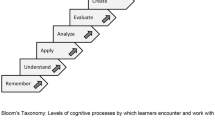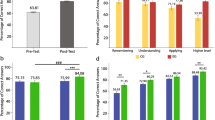Abstract
Recently, several articles have suggested that the flipped classroom could be an ideal model for pre-clinical medical education. The flipped classroom approach enables instructor-led time to be dedicated to integration and critical thinking exercises, while students learn foundational material outside of class via online videos or reading assignments. However, few studies have been published on the efficacy of this model for pre-clinical medial students. In this paper, we describe the implementation of a fully flipped classroom in a systems physiology course at The University of North Carolina School of Medicine. The organization of this flipped classroom aimed to keep contact hours and home-study hours equal to the hours previously used in the lecture-based course. With the implementation of the flipped classroom, both student performance on examination and student satisfaction with the course improved slightly compared to those of previous years where the curriculum was primarily delivered by lectures. This paper describes an example of a fully flipped course that demonstrated gains in performance and student course evaluations of a medical school pre-clinical course, and suggests that the flipped classroom could be a useful and successful educational approach in medical curricula.

Similar content being viewed by others
References
Cooke M, Irby DM, Sullivan W, Ludmerer KM. American medical education 100 years after the Flexner report. N Engl J Med. 2006;355(13):1339–44. doi:10.1056/NEJMra055445.
Frenk J, Chen L, Bhutta ZA, Cohen J, Crisp N, Evans T, et al. Health professionals for a new century: transforming education to strengthen health systems in an interdependent world. Lancet. 2010;376(9756):1923–58. doi:10.1016/S0140-6736(10)61854-5.
Irby DM, Cooke M, O’Brien BC. Calls for reform of medical education by the Carnegie Foundation for the Advancement of Teaching: 1910 and 2010. Acad Med: J Assoc Am Med Coll. 2010;85(2):220–7. doi:10.1097/ACM.0b013e3181c88449.
Prober CG, Heath C. Lecture halls without lectures—a proposal for medical education. N Engl J Med. 2012;366(18):1657–9. doi:10.1056/NEJMp1202451.
Bligh DA. What’s the use of lectures? San Francisco: Jossey-Bass; 2000.
Engel CE. Problem-based learning. Br J Hosp Med. 1992;48(6):325–9.
Michaelsen LK. Team-based learning for health professions education : a guide to using small groups for improving learning. 1st ed. Sterling: Stylus; 2008.
Michaelsen LK, Knight AB, Fink LD. Team-based learning : a transformative use of small groups. Westport: Praeger; 2002.
Mehta NB, Hull AL, Young JB, Stoller JK. Just imagine: new paradigms for medical education. Acad Med: J Assoc Am Med Coll. 2013;88(10):1418–23. doi:10.1097/ACM.0b013e3182a36a07.
Prober CG, Khan S. Medical education reimagined: a call to action. Acad Med: J Assoc Am Med Coll. 2013;88(10):1407–10. doi:10.1097/ACM.0b013e3182a368bd.
Means B, Toyama Y, Murphy R, Bakia M, Jones K. Evaluation of evidence-based practices in online learning: a meta-analysis and review of online learning studies. In: Education USDo, editor. Washington, DC: United States Department of Education; 2010.
Bishop JL, Verleger MA. The flipped classroom: a survey of the results. American Society for Engineering Education Annual Conference and Exposition; Atlanta, GA2013.
Missildine K, Fountain R, Summers L, Gosselin K. Flipping the classroom to improve student performance and satisfaction. J Nurs Educ. 2013;52(10):597–9. doi:10.3928/01484834-20130919-03.
Tune JD, Sturek M, Basile DP. Flipped classroom model improves graduate student performance in cardiovascular, respiratory, and renal physiology. Adv Physiol Educ. 2013;37(4):316–20. doi:10.1152/advan.00091.2013.
McLaughlin JE, Roth MT, Glatt DM, Gharkholonarehe N, Davidson CA, Griffin LM, et al. The flipped classroom: a course redesign to foster learning and engagement in a health professions school. Acad Med: J Assoc Am Med Coll. 2014;89(2):236–43. doi:10.1097/ACM.0000000000000086.
Sharma N, Lau CS, Doherty I, Harbutt D. How we flipped the medical classroom. Medical teacher. 2014:1–4. doi:10.3109/0142159X.2014.923821.
Sitticharoon C, Srisuma S, Kanavitoon S, Summachiwakij S. Exploratory study of factors related to educational scores of first preclinical year medical students. Adv Physiol Educ. 2014;38(1):25–33. doi:10.1152/advan.00162.2012.
Felder E, Fauler M, Geiler S. Introducing e-learning/teaching in a physiology course for medical students: acceptance by students and subjective effect on learning. Adv Physiol Educ. 2013;37(4):337–42. doi:10.1152/advan.00158.2012.
Robin BR, McNeil SG, Cook DA, Agarwal KL, Singhal GR. Preparing for the changing role of instructional technologies in medical education. Acad Med: J Assoc Am Med Coll. 2011;86(4):435–9. doi:10.1097/ACM.0b013e31820dbee4.
Bowe CM, Voss J, Thomas AH. Case method teaching: an effective approach to integrate the basic and clinical sciences in the preclinical medical curriculum. Med Teach. 2009;31(9):834–41.
Gordon JA, Brown DF, Armstrong EG. Can a simulated critical care encounter accelerate basic science learning among preclinical medical students? A pilot study. Simulation in healthcare : journal of the Society for Simulation in Healthcare. 2006;1 Spec no.:13–7.
Gordon JA, Hayden EM, Ahmed RA, Pawlowski JB, Khoury KN, Oriol NE. Early bedside care during preclinical medical education: can technology-enhanced patient simulation advance the Flexnerian ideal? Acad Med: J Assoc Am Med Coll. 2010;85(2):370–7. doi:10.1097/ACM.0b013e3181c88d74.
Fagen AP, Crouch CH, Mazur E. Peer Instruction: Results from a Range of Classrooms. Phys Teach. 2002;40:206–9. doi:10.1119/1.1474140.
Smith MK, Wood WB, Adams WK, Wieman C, Knight JK, Guild N, et al. Why peer discussion improves student performance on in-class concept questions. Science. 2009;323(5910):122–4. doi:10.1126/science.1165919.
Deslauriers L, Schelew E, Wieman C. Improved learning in a large-enrollment physics class. Science. 2011;332(6031):862–4. doi:10.1126/science.1201783.
Pluta WJ, Richards BF, Mutnick A. PBL and beyond: trends in collaborative learning. Teach Learn Med. 2013;25 Suppl 1:S9–16. doi:10.1080/10401334.2013.842917.
Cohen J. A Power Prime. Psychol Bull. 1992;112(1):155–9.
Hashmi NR. Team Based Learning (TBL) in Undergraduate Medical Education. J Coll Phys Surg-Pak: JCPSP. 2014;24(8):553–6. doi:08.2014/JCPSP.553556.
Koles PG, Stolfi A, Borges NJ, Nelson S, Parmelee DX. The impact of team-based learning on medical students’ academic performance. Acad Med: J Assoc Am Med Coll. 2010;85(11):1739–45. doi:10.1097/ACM.0b013e3181f52bed.
Neville AJ. Problem-based learning and medical education forty years on. A review of its effects on knowledge and clinical performance. Med Princ Pract: Int J Kuwait Univ Health Sci Cent. 2009;18(1):1–9. doi:10.1159/000163038.
Prosser M, Sze D. Problem-based learning: student learning experiences and outcomes. Clin Linguist Phon. 2014;28(1–2):131–42. doi:10.3109/02699206.2013.820351.
Sisk RJ. Team-based learning: systematic research review. J Nurs Educ. 2011;50(12):665–9. doi:10.3928/01484834-20111017-01.
Boehler ML, Schwind CJ, Folse R, Dunnington G, Markwell S, Dutta S. An evaluation of study habits of third-year medical students in a surgical clerkship. Am J Surg. 2001;181(3):268–71.
Beale EG, Tarwater PM, Lee VH. A retrospective look at replacing face-to-face embryology instruction with online lectures in a human anatomy course. Anat Sci Educ. 2014;7(3):234–41. doi:10.1002/ase.1396.
Chao SH, Brett B, Wiecha JM, Norton LE, Levine SA. Use of an online curriculum to teach delirium to fourth-year medical students: a comparison with lecture format. J Am Geriatr Soc. 2012;60(7):1328–32. doi:10.1111/j.1532-5415.2012.04035.x.
Davidson MR. A phenomenological evaluation: using storytelling as a primary teaching method. Nurse Educ Pract. 2004;4(3):184–9. doi:10.1016/S1471-5953(03)00043-X.
Dunkin MJ. A Review of Research on Lecturing. High Educ Res Dev. 1983;2(1):63–78.
Cooper C, Orban D, Henry R, Townsend J. Teaching and storytelling: an ethnographic study of the instructional process in the college classroom. Instr Sci. 1983;12:171–90.
Alamro AS, Schofield S. Supporting traditional PBL with online discussion forums: a study from Qassim Medical School. Med Teach. 2012;34 Suppl 1:S20–4. doi:10.3109/0142159X.2012.656751.
Acknowledgments
The authors would like to thank the UNC School of Medicine class of 2017 for their willingness to participate in surveys about the flipped classroom and their open-minded approach to this new method. We would also like to thank the faculty members from the Department of Cell Biology and Physiology who were part of the flipped classroom portion of the course (Christopher Dekanney, Carol Otey, Scott Randell, and Robert Sealock). We would also like to thank Dale Krams for help designing the flipped classroom survey.
Author information
Authors and Affiliations
Corresponding author
Rights and permissions
About this article
Cite this article
Street, S.E., Gilliland, K.O., McNeil, C. et al. The Flipped Classroom Improved Medical Student Performance and Satisfaction in a Pre-clinical Physiology Course. Med.Sci.Educ. 25, 35–43 (2015). https://doi.org/10.1007/s40670-014-0092-4
Published:
Issue Date:
DOI: https://doi.org/10.1007/s40670-014-0092-4




